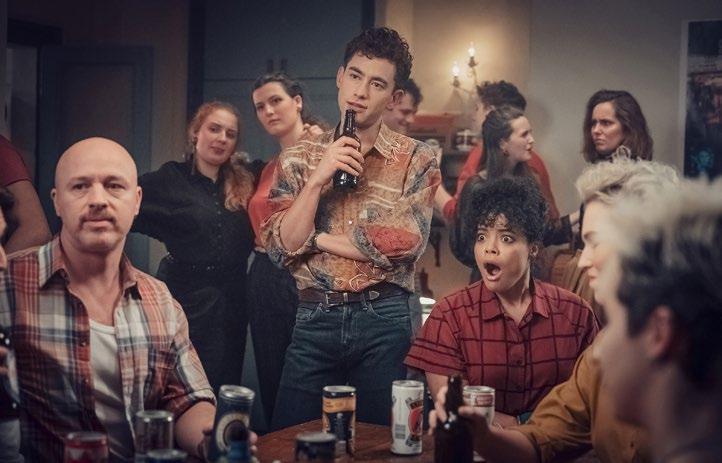
6 minute read
Hidden figures
Channel 4 It’s a Sin
A high-powered RTS panel hears how Barb is poised to publish regular audience figures for streaming services
Advertisement
After years of refusal by the global streaming companies to share their viewing data, new light will soon be shed on the performance of Netflix, Amazon and Disney+ – and PSB streaming services such as All 4 and BBC iPlayer – by the industry ratings body Barb.
From the late summer, Barb expects to publish regular viewing figures for SVoD services on the same basis as those for broadcast television. This will allow meaningful comparisons to be made for the first time.
The move comes as the Digital, Culture, Media and Sport Committee of the House of Commons has recommended that the streamers should be required to share top-line viewing data for UK shows with Ofcom and domestic broadcasters, so that the full reach of PSB content can be assessed.
At a recent RTS lunchtime event, “Hidden figures: Understanding TV audiences in the on-demand age”, Barb’s Chief Executive, Justin Sampson, unveiled previously unreported figures for the fourth series of The Crown. He revealed that 3.7 million people watched episode 1 of the Netflix series during the first seven days it was available. Moreover, “episodes 9 and 10 were watched by around 1.4m people, which points to just under 40% of its viewers getting through the whole series in seven days”.
Sampson also used insights from Channel 4’s It’s a Sin to show how streaming data could increase understanding of audience behaviour, including the relationship between live and on-demand viewing. It’s a Sin premiered on Channel 4 on 22 January this year and all five episodes were immediately available on All 4.
The Barb chief said that 4 million people watched episode 5 before it aired in Channel 4’s live linear schedule on 19 February. Far fewer – nearly 900,000 – watched the episode live, while another 1.4 million watched in the four weeks following transmission.
The data also revealed that just under 90% of the series’ pre-broadcast audience watched on a TV set, with the balance split between PCs, tablets and smartphones. Sampson added: “Not surprisingly, the live audience was
almost entirely on the TV set, and just under 10% of the post-broadcast audience watched on a PC, tablet or smartphone.”
He said this showed the value of broadcasters collaborating with Barb. It was much more challenging with the streaming companies, many of which were reluctant to share information. But he revealed that Barb was now in talks with two major streamers over possible collaboration, having been firmly rebuffed by Amazon a year or so ago.
“In 2017, we had an enquiry from Amazon about the possibility of measuring audiences of The Grand Tour,” he said. “Our answer was yes — with its co-operation — and we highlighted that, as an industry currency, the numbers would be published to all our subscribers. On that bombshell, the trail went cold.
“In light of this challenge, Barb set out to measure audiences for Amazon and other SVoD services with or without their involvement. And we’re now on the verge of going live with our solutions, as seen in that sneak preview of our figures for The Crown.
“We are in the final stages of due diligence, prior to the launch later on in the summer, and we’d be delighted for the streamers to have the collaborative relationship with us that we have with the broadcasters.”
Sampson noted that Netflix had been helpful with technical information when Barb began to attach viewing meters to the wi-fi routers in some of its 5,000 panel homes (traditionally, these have always been attached to the TV set).
And, while he wouldn’t “give a running commentary” on his talks with the streamers, he said a third company was about to start a conversation with Barb.
Speaking in the same RTS session, Sarah Rose, chief operating and commercial officer, UK, for Channel 5’s owner, ViacomCBS Networks International, welcomed Barb’s new research as a “game changer” that would reduce confusion and misunderstanding.
“It’s the easiest mistake to make but a number of commissioners have made it over the years,” she said. “You look at the Barb statistics for linear viewing and then look at the number of streams for VoD and add them together. But you can’t do that, because the number of streams is just the stream-starts, which could be people sampling something and either not liking it or getting interrupted.
“Now that Barb is measuring across the piece, you get the average audience for VoD, which you can look at in aggregate with linear, and that gives a proper understanding of the scale of viewing, rather than simply taking a very shiny, sexy big number for VoD.”
Lucy Bristowe, Sky Media’s director of insight and research, said: “At Sky, we have a lot of our own data and download information and audience information but it’s quite hard to get into the real demographics – who’s actually in front of the screen watching that piece
of content – and that’s what the Barb technology does very well for us.
“A great recent example was Your Honor on Sky Atlantic. From the Barb data, we could see the viewing growing as we pre-TX-ed it and then keep growing, and we could layer on the Barb data to see who those people were in terms of demographics, and [in what other ways] they watched. While big data is fantastic, Barb gives us a fuller picture of what is going on.”
Wayne Garvie, President of international production for Sony Pictures Television, said the figure which stood out for him in Sampson’s presentation was the viewing for The Crown, produced by Left Bank Pictures, which is owned by Sony.
He said: “On a platform that is in about half UK households of free-to-air [viewers], it can now reach free-to-air numbers. And if you look at The Crown audience and a BBC One audience, they are probably really similar, so that, to me, says that Netflix is mainstream.
“That has an impact on the question of when you sell a show, and where do you sell it? We had a taste of this recently with a show called Behind Her Eyes, which could have played on ITV or the BBC, but went to Netflix and it surprised us all by being such a big success. I know that Anne Mensah [vice-president of original series at Netflix] would like more shows like that – and Justin’s information made me think that mainstream now [includes] Netflix and Amazon.”
Sampson’s final slide showed the weekly reach of the four biggest streaming services, going back to the beginning of August. He said seasonal factors were at play — viewing was

typically higher in the winter than the summer — and the lockdown from 6 January would also have had an effect.
“Having started this period with a weekly reach of just over 25%, Netflix topped 30% during November, when The Crown launched,” he said. “During March, it was achieving a weekly reach of around one-third of all [people] aged four and above.
“We can see how YouTube is watched on a TV set by around one in five people, although we know — not shown on this chart — that YouTube generates much larger audiences on smartphones, tablets and PCs than any broadcaster or SVoD services.
“For Amazon Prime Video, the eye is drawn to two spikes in its audience last December. These both coincided with Premier League match days when Amazon had the rights to live-stream all the games.”
Hidden figures no more. n
The Crown
Netflix
Report by Torin Douglas. ‘Hidden figures: Understanding TV audiences in the on-demand age’ was an RTS event held on 20 April. It was chaired by Variety international editor Manori Ravindran. The producer was Steve Clarke.










